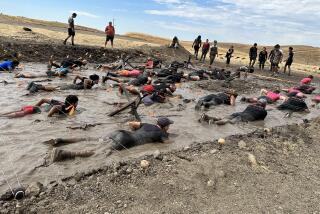Mystery illness at Playboy Mansion linked to bacterium that causes Legionnaires disease
- Share via
After weeks of medical detective work, public health officials have moved much closer to solving the mystery illness that sickened more than 120 people at the Playboy Mansion in February.
The bacterium that causes Legionnaires disease has been found in the mansion’s grotto, the famed artificial cave that houses a whirlpool spa.
The bacterium, Legionella pneumophila, is a suspect in the illnesses among attendees at a DomainFest fundraiser Feb. 3 at the mansion, in the Holmby Hills neighborhood of Los Angeles. The Legionella bacterium can cause serious illness, including pneumonia. H1N1 flu is also a suspect in the outbreak.
Health authorities had previously said only that the bacterium was identified at a whirlpool spa at the Playboy Mansion. The precise location of that spa was made public during a presentation by Dr. Caitlin Reed at a conference of the Centers for Disease Control and Prevention in Atlanta last week.
The Times has reviewed a copy of the presentation, which the county made available after a Public Records Act request.
Among everyone who attended the three-day DomainFest, investigators found the highest risk of illness in people who went to the Playboy Mansion party on Feb. 3.
Reed’s presentation to the CDC was a classic whodunit public disease investigation. Twitter, Facebook and an online poll were key tools scientists used to track down the source of illness.
Los Angeles County health officials were spurred into action on Feb. 11 after receiving a call from a journalist asking about the large number of illnesses following DomainFest. Many who went to the convention, at which the latest in the Internet industry was discussed, were writing on blogs and in social media about widespread illnesses among attendees.
On Feb. 7, for example, a person wrote on his Facebook page, “Domainerflu count: Who else caught the disease at DFG?” The names of three dozen were counted in the comments in the post.
The presentation by Reed also quoted Ron Jackson, the author
of an industry blog, DN Journal, who attended the convention and said he knew of four dozen people who fell ill, including his wife. He wrote that one person told him he developed pneumonia and that “this is the sickest he has ever been.” Another man told him he also had pneumonia but began to recover after taking what he described as strong antibiotics.
The author quoted one attendee as speculating that the fog machine “that was blowing moist air into the huge party tent all night could have been distributing microbial hitchhikers.”
The Feb. 8 post noted that the author’s daughter, a medical student, advised him that if “people are getting pneumonia” and “there is a suspected water source as the culprit,” attendees should worry about bacterial infections and “definitely need to see their doctors. So many people getting sick in one place, sounds like a case for the CDC.”
Health investigators then used an online poll sent to all 715 conference attendees to get a better handle on the disease outbreak. They received more than 400 responses.
The survey found that 123 people fell sick with fever and at least one other symptom, such as headache, cough, shortness of breath or aches. A key clue was that 69 people got sick on the same day, Feb. 5, indicating that the outbreak was probably caused by a single source.
Social media outlets were helpful, according to Reed’s presentation, because they allowed investigators to identify the outbreak quickly; enabled them to receive responses quickly from attendees, who had traveled from 30 countries; and allowed for the issuing of speedy recommendations for patients to receive lab testing.
But there was also a downside, including “wasted effort responding to rumors.”
The name of Legionnaires disease stems from its discovery in 1976 when attendees at an American Legion convention in Philadelphia became sick with the bacterium and developed pneumonia. About 8,000 to 18,000 people are hospitalized with the disease every year in the United States, according to the CDC.
Healthy people usually recover from the bacterial disease, which can be treated with antibiotics, but death can occur in 5% to 30% of cases, the CDC said.
A milder version of illness caused by the Legionella bacterium is called Pontiac fever; it does not cause pneumonia but does cause fever, chills, cough and headaches.
The Legionella bacterium normally grows best in warm water, as in whirlpool spas. People can become infected when they breathe contaminated mist, according to the CDC. The disease cannot spread from one person to another.
Reed is a physician with the CDC’s Epidemic Intelligence Service, an elite group of disease scientists, on loan to the Los Angeles County Department of Public Health.
A Playboy spokeswoman did not return a call seeking comment.







